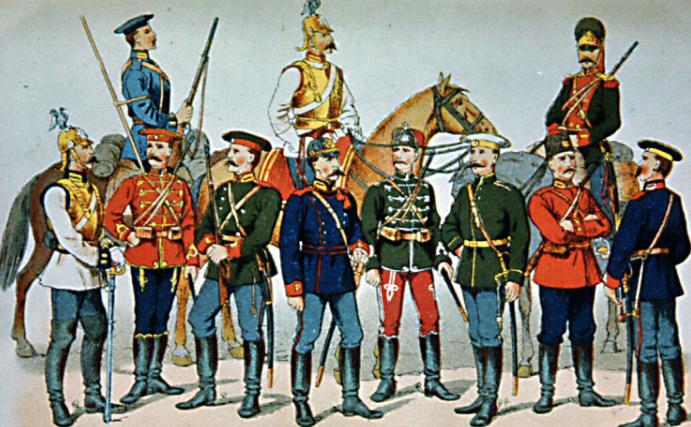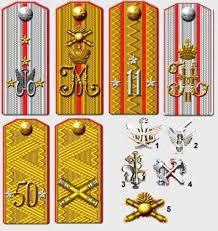The vastness of our country, its wealth invariably attracted many conquerors who sought to wipe Russia off the face of the earth as a state. From the beginning of the existence of ancient settlements to the present day, the threat of invasion of our territory is constantly present. But the Russian land has defenders, the history of the armed forces of our country begins with epic heroes and princely squads. The Russian imperial army, the red army of the USSR, the modern armed forces of the Russian Federation support and strengthen the glory of domestic weapons.
History
The formation of the regular armed forces of Russia begins under Tsar Alexei Mikhailovich, their basis was the existing archery units and parts of the city squads. The troops of foreign Western European powers were taken as a model. The "new army" was formed on the basis of recruitment, the service life was life. 18 orders controlled the recruitment, training and provision of ground troops. Irregular (voluntary) horse-drawn formations were not included in the official number; they were composed of Cossacks, Caucasians, Siberians, and Central Asian nationalities. The process of reforming troops at the end of the 17th century was begun by Peter I. It was from this moment that the Russian imperial army began its history. After the rebellion of 1698, the archery regiments were disbanded, the number of orders was reduced to three, and urgent mobilization was carried out. According to its results, the Russian army received 25 infantry and 2 dragoon (cavalry) regiments, the structure of units and their management changed significantly. A "Military Charter" was created, according to which new recruits were trained, the Transfiguration and Semenov formations served as a model.

Structure
Peter I paid great attention to the clear division of troops into infantry, artillery, cavalry and navy. This structure made it possible to bring all weapons to a single standard, streamline supplies by creating factories that carried out government orders. The Russian imperial army increased due to the fleet, created at the initial stage by foreign engineers. By 1722, the ground forces totaled 200 thousand soldiers and officers, the fleet was equipped with 500 ships (rowing and sailing). All weapons were standardized in a European manner, horse artillery was created, the first educational institutions for the training of military personnel were opened. The Table of Ranks created by Peter divided all the types of ground forces by clan, and allocated a fleet to a separate unit. At the present stage, this division is used in a modernized version, in accordance with the requirements of today. Further reform of the army was carried out by the great commander A.V. Suvorov at the end of the 18th century, more serious changes in the structure and management are associated with the name of Emperor Alexander II.
Composition
More than 75% of the armed forces were infantry regiments formed on a recruitment basis (service life was reduced from life to 25 years), about 20 -25% - cavalry. The peoples of Transcaucasia, Siberia, Central Asia were exempted from compulsory military service, but paid tax to the state treasury. Often these regions, following the example of the Cossacks, created equestrian volunteer regiments that were not included in official statistics, but took an active part in military operations. Officers of the Russian imperial army were of obligatory noble origin until 1762, when the "Liberty Manifesto" was adopted. Under Peter I, most of the military commanders were drawn from among foreigners, this was due to the lack of trained domestic personnel. Subsequently, their recruitment to the service was limited in accordance with the requirements personally developed by Peter I.
Outfit
The troops of the foreign system created by Peter I were equipped according to the traditions existing in Europe at that time with weapons and a uniform of the Prussian standard. Thus, the armies of Prussia, Great Britain, Russia, and Austria were equipped. Traditional gaiters, cocked caps, wigs with pigtails made it difficult to quickly collect troops and the speed of response to the threat in battle. The first changes in the uniform of the uniform began the British, who faced a different climate during military operations in the territory of future colonies. The form of the Russian imperial army radically changed in the second half of the 18th century. Clothing becomes more practical and simple. For the huge number of types of military formations existing at that time, 86 sketches were developed. The Russian imperial army wore uniforms, the creation of which was directly related to the president of the military college Count G. A. Potemkin. For all its simplicity, the form was overloaded with decorative elements: lapels were stitched with colored fabrics, gilded weaving, complex-shaped stripes, helmets designed for parades, but unsuitable for everyday wear and combat conditions. The uniform reform did not affect all types of troops; some of the guards regiments wore Prussian uniforms until the beginning of the 19th century. In the future, the form was improved many times, but at the same time, the basic principle of reform was comfortable wearing in peacetime and during hostilities.

Shoulder straps
Not only the history of many army units, but also the elements of uniforms have gained legends. Epaulettes belong to this category, although its use is quite prosaic and has a clear practical purpose. For the first time this element of the uniform was used during the time of Peter I. The shoulder strap is attached to the seam of the sleeve and has a pinch valve. Its main function is to fasten the bag, which stores the things the soldier needs and ammunition. Gunners, officers, cavalrymen of that time did not wear shoulder straps, it was not necessary. Alexander I, in the process of reforming the army, an attempt was made to use epaulettes as a distinctive sign between the officers and ordinary. During this period, they become not only a distinction, but also a decorative element of the form, which was decorated with rich sewing and weaving. Shoulder straps of the Russian imperial army in the 19th century became an identification mark. By their color, applied monograms, it was possible to determine the type of troops, regiment and rank of each soldier. Mass mobilization during the First World War complicated this process, the number of units increased, respectively, the number of numbers and letters on uniform increased, which often led to confusion. The remnants of the imperial army, who fought after 1917 as the White Guards, wore an optional uniform, epaulets were used as decoration of their uniforms and rarely corresponded to the system adopted in the Russian Empire.

Military units
In Peter's times, regiments of the Russian imperial army bore the name of their commander. The first exception was the Semenov and Preobrazhensky compounds, which received the name from the settlement. In the future, army units were named after Russian cities, while the regiment was not formed or even based at the station whose name it bears. Some units bore the names of "chefs", as a rule, members of the royal family acted in this capacity. Such regiments had distinctive features in uniform; their uniforms were decorated with special insignia. During the reformation of the imperial army, Alexander introduced a simplified designation system for military units. Their names corresponded to the place of formation with the assignment of a serial number. In the future, the awards and titles received for successfully conducted operations became part of the regiment's name.
Number
At the beginning of the 20th century, the Russian imperial army was the largest in Europe. The General Staff was the head of the administrative corps. The recruit service was abolished in 1874, it was replaced by a system of all-class military service. All males from 21 years of age were called up for service, the term of service for the ground forces was 6 years, in the Navy - 7. After passing the compulsory training, the military personnel went into the reserve for a period of 9 to 3 years. In the event of general mobilization, the reservists became the first to be called up for active service. As a percentage of the population, the Russian army could mobilize 2.5% in wartime. In absolute terms, this amounts to about 3 million soldiers and officers. With the development of technology, the army is replenished with imperial aviation, tank, automobile and railway troops.
Glory to Russian weapons
Military successes and defeats accompanied any commander. In this regard, the Russian imperial army is the legendary troops, the names of Suvorov A.V., Kutuzov M.I., Ushakova F.F., Nakhimova P.S., Davydova D.V. are synonymous with heroism and courage. The great commanders left their name in world history and consolidated the glory of Russian weapons. After the disbandment of the imperial army in 1918, the history of its creation, existence, victories and defeats was interpreted in a truncated form. But it contains invaluable experience of many generations, which must be taken into account by modern military officers and commanders-in-chief.